Recent Progress in Fast Distributed Brillouin Optical Fiber Sensing
Abstract
1. Introduction
2. Operation Principle
3. The Speed Limitations of the Distributed Measurement for the Classical BOTDA Scheme
4. Developments of the Fast BOTDA Schemes
4.1. Optical Frequency Comb Based Fast BOTDA
4.2. Optical Frequency-Agile Based Fast BOTDA
4.3. Slope-Assisted Fast BOTDA
4.3.1. Increasing the Slope Numbers
4.3.2. Enlarging the Monotonous Slope of the Sensing Curve
4.4. Optical Chirp Chain Technique for Fast BOTDA
5. Challenges and Future Perspectives
6. Conclusions
Author Contributions
Funding
Conflicts of Interest
References
- Zhou, D.; Dong, Y.; Wang, B.; Pang, C.; Ba, D.; Zhang, H.; Lu, Z.; Li, H.; Bao, X. Single-shot BOTDA based on an optical chirp chain probe wave for distributed ultrafast measurement. Light Sci. Appl. 2018, 7, 32. [Google Scholar] [CrossRef]
- Bashan, G.; Diamandi, H.H.; London, Y.; Preter, E.; Zadok, A. Optomechanical time-domain reflectometry. Nat. Commun. 2018, 9, 2991. [Google Scholar] [CrossRef] [PubMed]
- Chow, D.M.; Yang, Z.; Soto, M.A.; Thévenaz, L. Distributed forward Brillouin sensor based on local light phase recovery. Nat. Commun. 2018, 9, 2990. [Google Scholar] [CrossRef] [PubMed]
- Kurashima, T.; Horiguchi, T.; Tateda, M. Distributed-temperature sensing using stimulated Brillouin scattering in optical silica fibers. Opt. Lett. 1990, 15, 1038–1040. [Google Scholar] [CrossRef] [PubMed]
- Bao, X.; Chen, L. Recent Progress in Brillouin Scattering Based Fiber Sensors. Sensors 2011, 11. [Google Scholar] [CrossRef] [PubMed]
- Hotate, K. Recent achievements in BOCDA/BOCDR. In Proceedings of the IEEE SENSORS 2014, Valencia, Spain, 2–5 November 2014; pp. 142–145. [Google Scholar]
- Bao, X.; Chen, L. Recent Progress in Distributed Fiber Optic Sensors. Sensors 2012, 12. [Google Scholar] [CrossRef] [PubMed]
- Agrawal, G.P. Nonlinear Fiber Optics, 4th ed.; Elsevier Academic Press: Amsterdam, The Netherlands, 2007; ISBN 9780123695161. [Google Scholar]
- Boyd, R.W. Stimulated Brillouin and Stimulated Rayleigh Scattering. In Nonlinear Optics, 3rd ed.; Academic Press: Burlington, NJ, USA, 1992; Chapter 9; pp. 429–471. ISBN 978-0-12-369470-6. [Google Scholar]
- Dong, Y.; Chen, L.; Bao, X. High-Spatial-Resolution Time-Domain Simultaneous Strain and Temperature Sensor Using Brillouin Scattering and Birefringence in a Polarization-Maintaining Fiber. IEEE Photonics Technol. Lett. 2010, 22, 1364–1366. [Google Scholar] [CrossRef]
- Zhou, D.; Dong, Y.; Wang, B.; Jiang, T.; Ba, D.; Xu, P.; Zhang, H.; Lu, Z.; Li, H. Slope-assisted BOTDA based on vector SBS and frequency-agile technique for wide-strain-range dynamic measurements. Opt. Express 2017, 25, 1889–1902. [Google Scholar] [CrossRef] [PubMed]
- Li, Y.; Zhang, L.; Fan, H.; Wang, L. A self-heterodyne detection Rayleigh Brillouin optical time domain analysis system. Opt. Commun. 2018, 427, 190–195. [Google Scholar] [CrossRef]
- Galindez-Jamioy, C.A.; Lopez-Higuera, J.M. Brillouin Distributed Fiber Sensors: An Overview and Applications. J. Sens. 2012, 2012, 17. [Google Scholar] [CrossRef]
- Song, K.Y.; Zou, W.; He, Z.; Hotate, K. All-optical dynamic grating generation based on Brillouin scattering in polarization-maintaining fiber. Opt. Lett. 2008, 33, 926–928. [Google Scholar] [CrossRef] [PubMed]
- Dong, Y.; Zhou, D.; Teng, L.; Xu, P.; Jiang, T.; Zhang, H.; Lu, Z.; Chen, L.; Bao, X. Phase-shifted Brillouin dynamic gratings using single pump phase-modulation: Proof of concept. Opt. Express 2016, 24, 11218–11231. [Google Scholar] [CrossRef] [PubMed]
- Teng, L.; Zhang, H.; Dong, Y.; Zhou, D.; Jiang, T.; Gao, W.; Lu, Z.; Chen, L.; Bao, X. Temperature-compensated distributed hydrostatic pressure sensor with a thin-diameter polarization-maintaining photonic crystal fiber based on Brillouin dynamic gratings. Opt. Lett. 2016, 41, 4413–4416. [Google Scholar] [CrossRef] [PubMed]
- Dong, Y.; Teng, L.; Tong, P.; Jiang, T.; Zhang, H.; Zhu, T.; Chen, L.; Bao, X.; Lu, Z. High-sensitivity distributed transverse load sensor with an elliptical-core fiber based on Brillouin dynamic gratings. Opt. Lett. 2015, 40, 5003–5006. [Google Scholar] [CrossRef] [PubMed]
- Li, Q.; Gan, J.; Wu, Y.; Zhang, Z.; Li, J.; Yang, Z. High Spatial Resolution BOTDR Based on Differential Brillouin Spectrum Technique. IEEE Photonics Technol. Lett. 2016, 28, 1493–1496. [Google Scholar] [CrossRef]
- Li, B.; Luo, L.; Yu, Y.; Soga, K.; Yan, J. Dynamic Strain Measurement Using Small Gain Stimulated Brillouin Scattering in STFT-BOTDR. IEEE Sens. J. 2017, 17, 2718–2724. [Google Scholar] [CrossRef]
- Minardo, A.; Bernini, R.; Ruiz-Lombera, R.; Mirapeix, J.; Lopez-Higuera, J.M.; Zeni, L. Proposal of Brillouin optical frequency-domain reflectometry (BOFDR). Opt. Express 2016, 24, 29994–30001. [Google Scholar] [CrossRef] [PubMed]
- Mizuno, Y.; Zou, W.; He, Z.; Hotate, K. Proposal of Brillouin optical correlation-domain reflectometry (BOCDR). Opt. Express 2008, 16, 12148–12153. [Google Scholar] [CrossRef] [PubMed]
- Horiguchi, T.; Tateda, M. Botda—Nondestructive Measurement of Single-Mode Optical Fiber Attenuation Characteristics Using Brillouin Interaction—Theory. J. Lightw. Technol. 1989, 7, 1170–1176. [Google Scholar] [CrossRef]
- Li, W.; Bao, X.; Li, Y.; Chen, L. Differential pulse-width pair BOTDA for high spatial resolution sensing. Opt. Express 2008, 16, 21616–21625. [Google Scholar] [CrossRef] [PubMed]
- Bernini, R.; Minardo, A.; Zeni, L. Distributed Sensing at Centimeter-Scale Spatial Resolution by BOFDA: Measurements and Signal Processing. IEEE Photonics J. 2012, 4, 48–56. [Google Scholar] [CrossRef]
- Kapa, T.; Schreier, A.; Krebber, K. 63 km BOFDA for Temperature and Strain Monitoring. Sensors 2018, 18. [Google Scholar] [CrossRef] [PubMed]
- Jeong, J.H.; Chung, K.H.; Lee, S.B.; Song, K.Y.; Jeong, J.-M.; Lee, K. Linearly configured BOCDA system using a differential measurement scheme. Opt. Express 2014, 22, 1467–1473. [Google Scholar] [CrossRef] [PubMed]
- Xu, P.; Dong, Y.; Zhang, J.; Zhou, D.; Jiang, T.; Xu, J.; Zhang, H.; Zhu, T.; Lu, Z.; Chen, L.; et al. Bend-insensitive distributed sensing in singlemode-multimode-singlemode optical fiber structure by using Brillouin optical time-domain analysis. Opt. Express 2015, 23, 22714–22722. [Google Scholar] [CrossRef] [PubMed]
- Dong, Y.; Bao, X.; Li, W. Differential Brillouin gain for improving the temperature accuracy and spatial resolution in a long-distance distributed fiber sensor. Appl. Opt. 2009, 48, 4297–4301. [Google Scholar] [CrossRef] [PubMed]
- Diakaridia, S.; Pan, Y.; Xu, P.; Zhou, D.; Wang, B.; Teng, L.; Lu, Z.; Ba, D.; Dong, Y. Detecting cm-scale hot spot over 24-km-long single-mode fiber by using differential pulse pair BOTDA based on double-peak spectrum. Opt. Express 2017, 25, 17727–17736. [Google Scholar] [CrossRef] [PubMed]
- Dong, Y.; Zhang, H.; Chen, L.; Bao, X. 2cm spatial-resolution and 2 km range Brillouin optical fiber sensor using a transient differential pulse pair. Appl. Opt. 2012, 51, 1229–1235. [Google Scholar] [CrossRef] [PubMed]
- Boyd, R.W. Nonlinear Optics, 3rd ed.; Academic Press: Burlington, ON, Canada, 2008; Chapter 9; ISBN 978-0-12-369470-6. [Google Scholar]
- Dong, Y.; Ba, D.; Jiang, T.; Zhou, D.; Zhang, H.; Zhu, C.; Lu, Z.; Li, H.; Chen, L.; Bao, X. High-Spatial-Resolution Fast BOTDA for Dynamic Strain Measurement Based on Differential Double-Pulse and Second-Order Sideband of Modulation. IEEE Photonics J. 2013, 5, 2600407. [Google Scholar] [CrossRef]
- Soto, M.A.; Bolognini, G.; Di Pasquale, F.; Thevenaz, L. Simplex-coded BOTDA fiber sensor with 1 m spatial resolution over a 50 km range. Opt. Lett. 2010, 35, 259–261. [Google Scholar] [CrossRef] [PubMed]
- Peled, Y.; Motil, A.; Tur, M. Fast Brillouin optical time domain analysis for dynamic sensing. Opt. Express 2012, 20, 8584–8591. [Google Scholar] [CrossRef] [PubMed]
- Yi, X.; Li, Z.; Bao, Y.; Qiu, K. Characterization of Passive Optical Components by DSP-Based Optical Channel Estimation. IEEE Photonics Technol. Lett. 2012, 24, 443–445. [Google Scholar] [CrossRef]
- Fang, J.; Xu, P.; Dong, Y.; Shieh, W. Single-shot distributed Brillouin optical time domain analyzer. Opt. Express 2017, 25, 15188–15198. [Google Scholar] [CrossRef] [PubMed]
- Minardo, A.; Zeni, L.; Bernini, R. Differential pulse-width pair BOTDA with fast fall-time pulses. In Proceedings of the 2011 IEEE SENSORS, Limerick, Ireland, 28–31 October 2011; pp. 897–900. [Google Scholar]
- Ba, D.; Zhou, D.; Wang, B.; Lu, Z.; Fan, Z.; Dong, Y.; Li, H. Dynamic Distributed Brillouin Optical Fiber Sensing Based on Dual-Modulation by Combining Single Frequency Modulation and Frequency-Agility Modulation. IEEE Photonics J. 2017, 9. [Google Scholar] [CrossRef]
- Bernini, R.; Minardo, A.; Zeni, L. Dynamic strain measurement in optical fibers by stimulated Brillouin scattering. Opt. Lett. 2009, 34, 2613–2615. [Google Scholar] [CrossRef] [PubMed]
- Motil, A.; Danon, O.; Peled, Y.; Tur, M. Pump-Power-Independent Double Slope-Assisted Distributed and Fast Brillouin Fiber-Optic Sensor. IEEE Photonics Technol. Lett. 2014, 26, 797–800. [Google Scholar] [CrossRef]
- Peled, Y.; Motil, A.; Yaron, L.; Tur, M. Slope-assisted fast distributed sensing in optical fibers with arbitrary Brillouin profile. Opt. Express 2011, 19, 19845–19854. [Google Scholar] [CrossRef] [PubMed]
- Ba, D.; Wang, B.; Zhou, D.; Yin, M.; Dong, Y.; Li, H.; Lu, Z.; Fan, Z. Distributed measurement of dynamic strain based on multi-slope assisted fast BOTDA. Opt. Express 2016, 24, 9781–9793. [Google Scholar] [CrossRef] [PubMed]
- Jin, C.; Wang, L.; Chen, Y.; Guo, N.; Yu, C.; Li, Z.; Lu, C. BOTDA sensor utilizing digital optical frequency comb based phase spectrum measurement. In Proceedings of the 2017 Conference on Lasers and Electro-Optics Pacific Rim (CLEO-PR), Singapore, 31 July–4 August 2017; pp. 1–3. [Google Scholar]
- Tu, X.B.; Luo, H.; Sun, Q.; Hu, X.Y.; Meng, Z. Performance analysis of slope-assisted dynamic BOTDA based on Brillouin gain or phase-shift in optical fibers. J. Opt. 2015, 17, 105503. [Google Scholar] [CrossRef]
- Urricelqui, J.; Zornoza, A.; Sagues, M.; Loayssa, A. Dynamic BOTDA measurements based on Brillouin phase-shift and RF demodulation. Opt. Express 2012, 20, 26942–26949. [Google Scholar] [CrossRef] [PubMed]
- Tu, X.; Sun, Q.; Chen, W.; Chen, M.; Meng, Z. Vector Brillouin Optical Time-Domain Analysis With Heterodyne Detection and IQ Demodulation Algorithm. IEEE Photonics J. 2014, 6, 1–8. [Google Scholar] [CrossRef]
- Dong, Y.; Wang, B.; Pang, C.; Zhou, D.; Ba, D.; Zhang, H.; Bao, X. 150 km fast BOTDA based on the optical chirp chain probe wave and Brillouin loss scheme. Opt. Lett. 2018, 43, 4679–4682. [Google Scholar] [CrossRef]
- Farahani, M.A.; Castillo-Guerra, E.; Colpitts, B.G. Accurate estimation of Brillouin frequency shift in Brillouin optical time domain analysis sensors using cross correlation. Opt. Lett. 2011, 36, 4275–4277. [Google Scholar] [CrossRef] [PubMed]
- Wang, F.; Zhan, W.; Zhang, X.; Lu, Y. Improvement of Spatial Resolution for BOTDR by Iterative Subdivision Method. J. Lightw. Technol. 2013, 31, 3663–3667. [Google Scholar] [CrossRef]
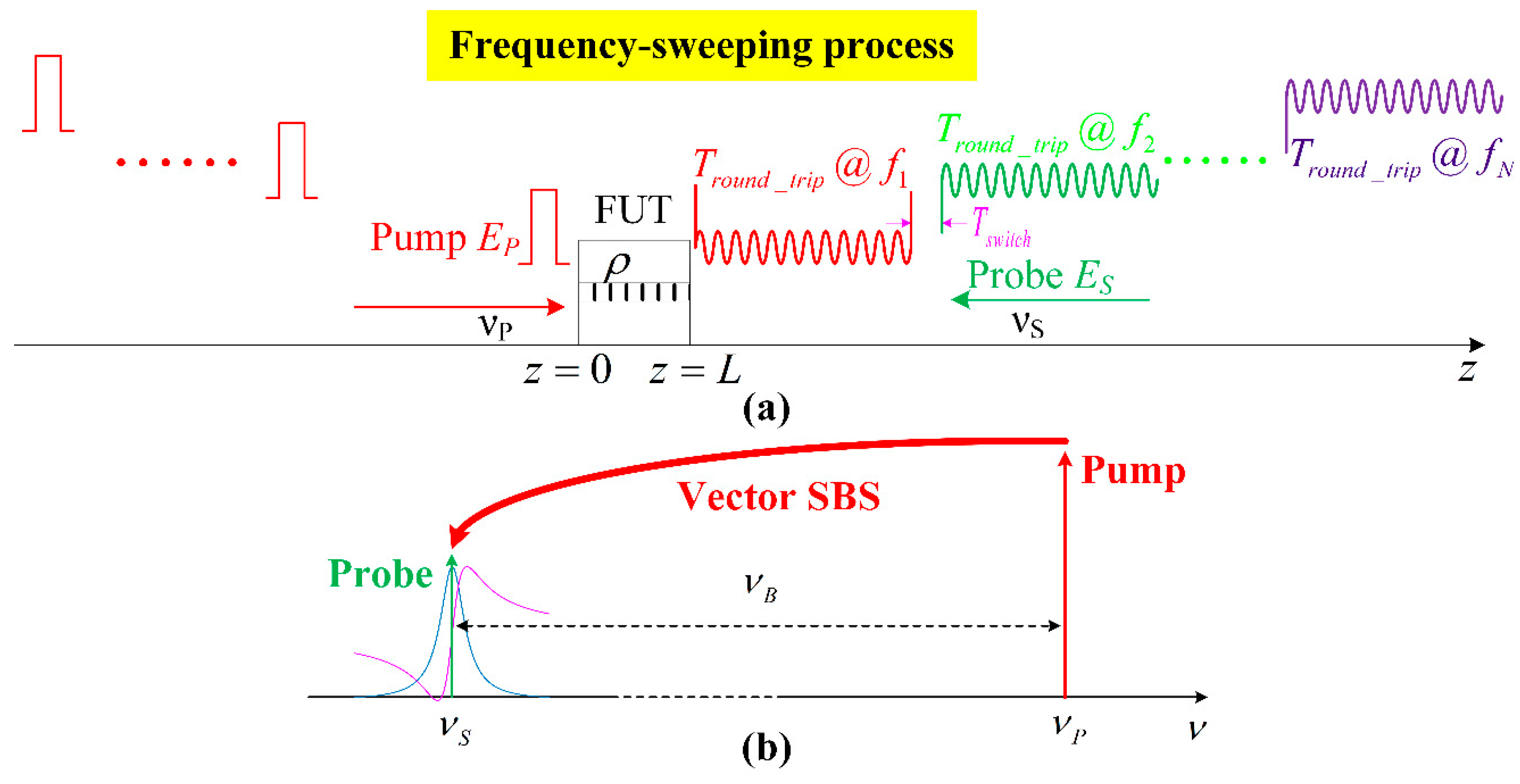
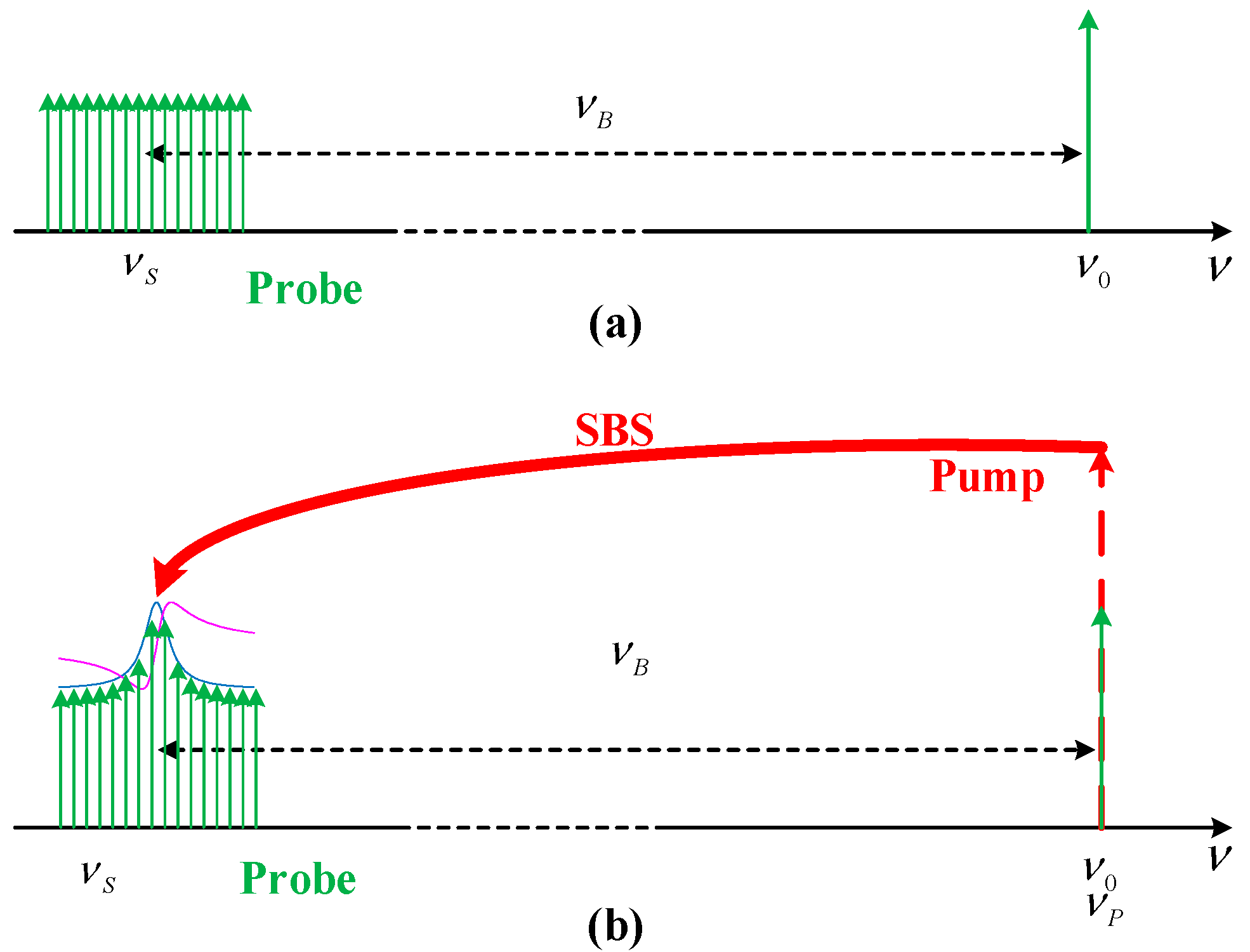
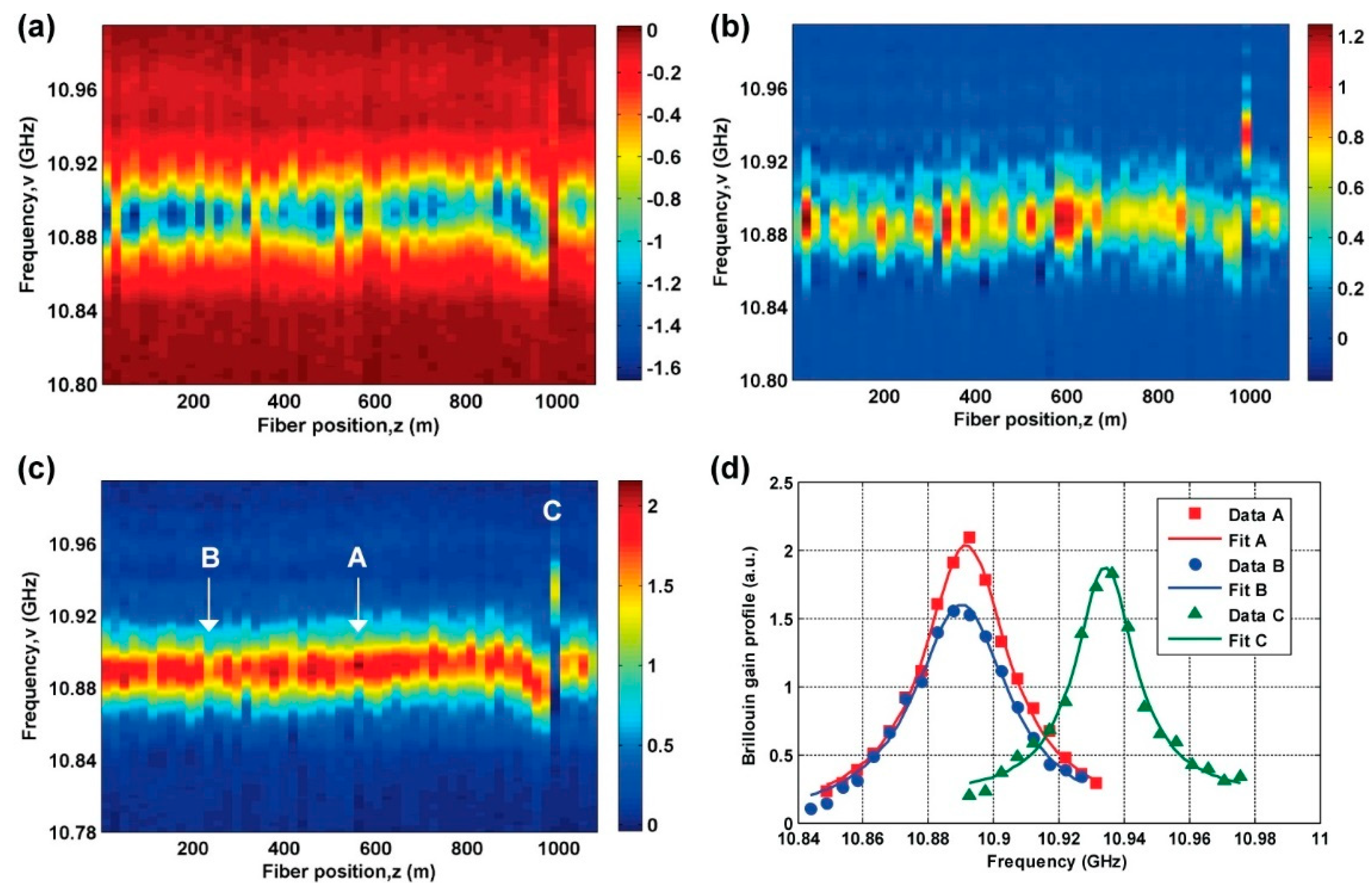


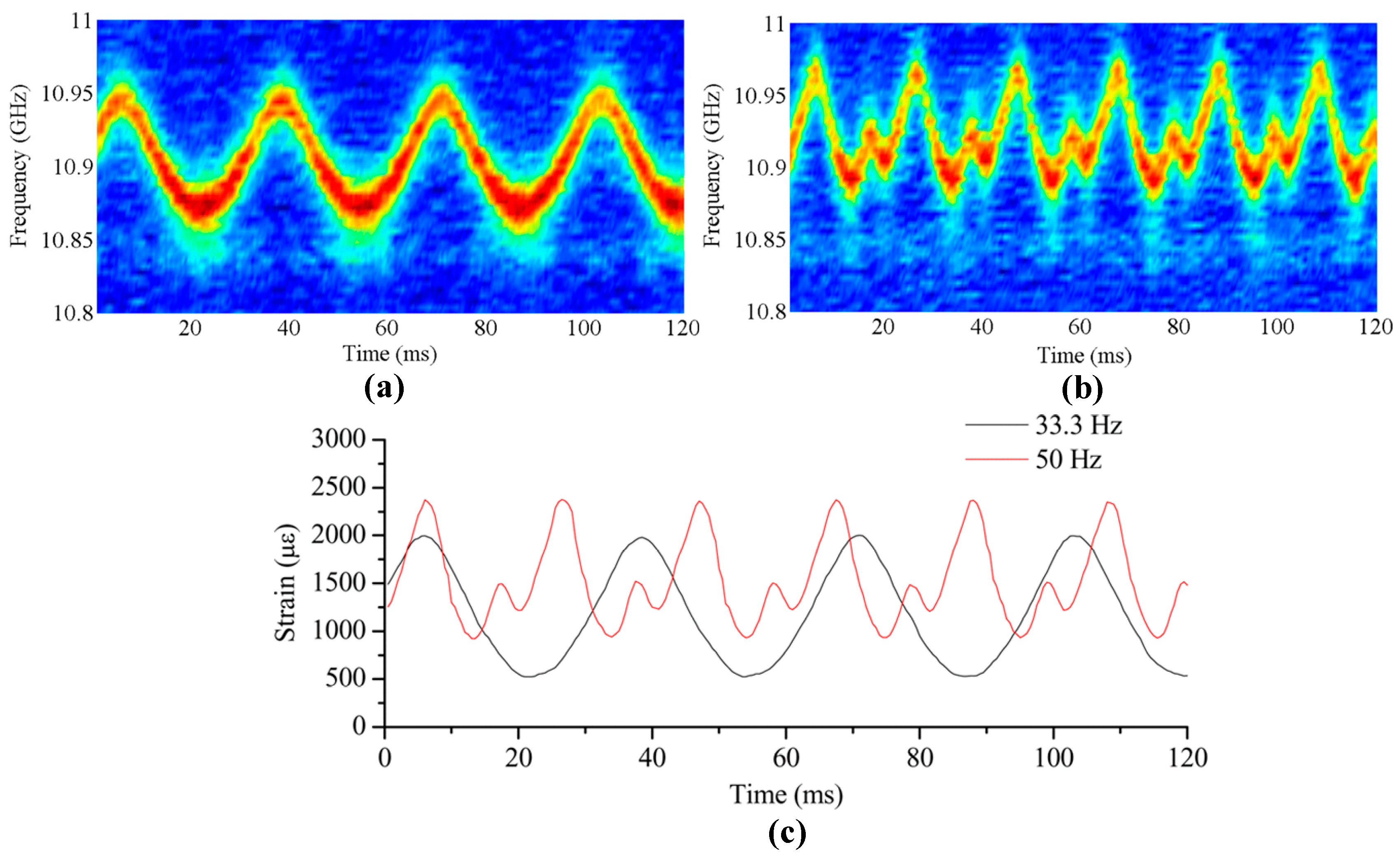
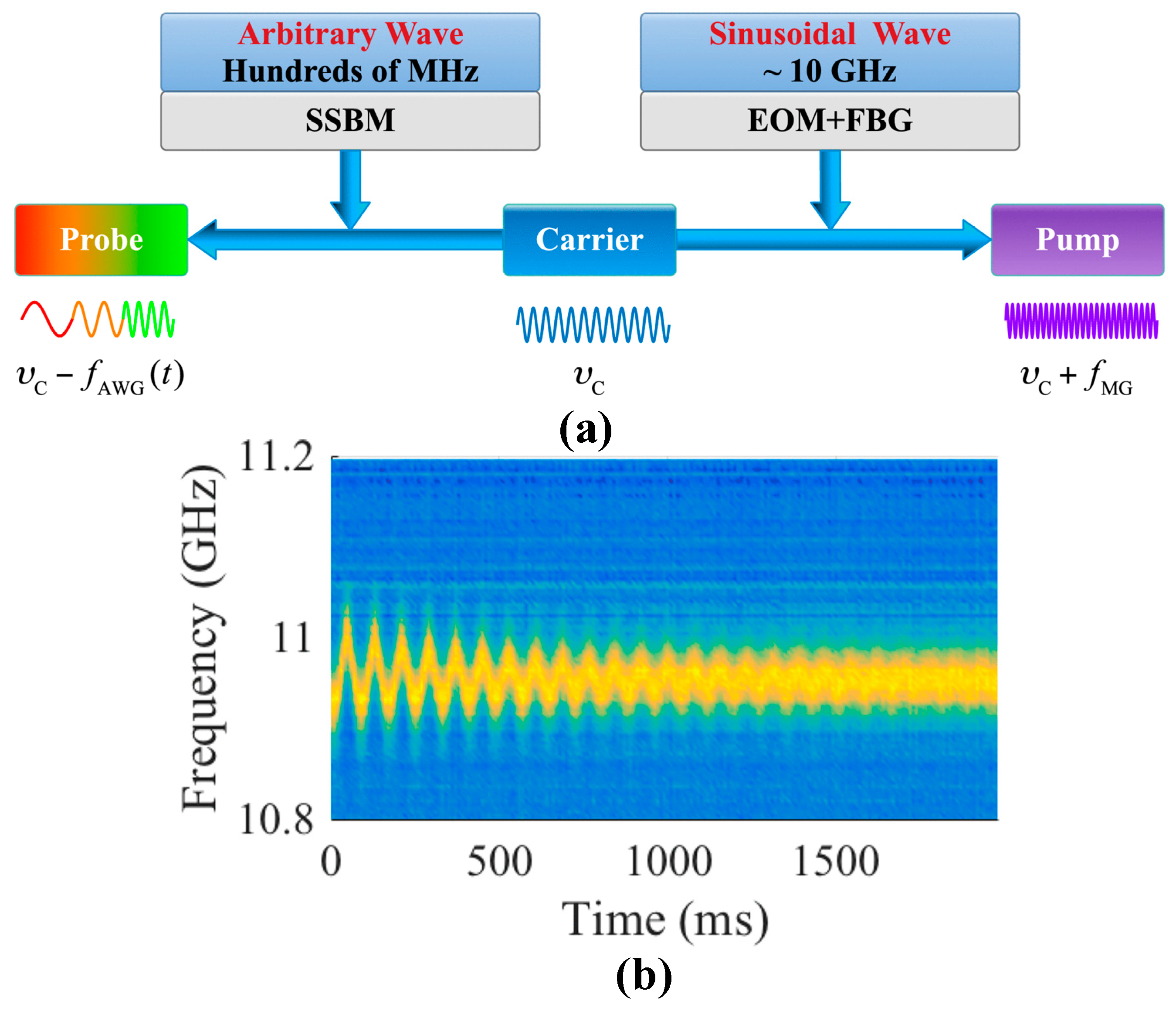


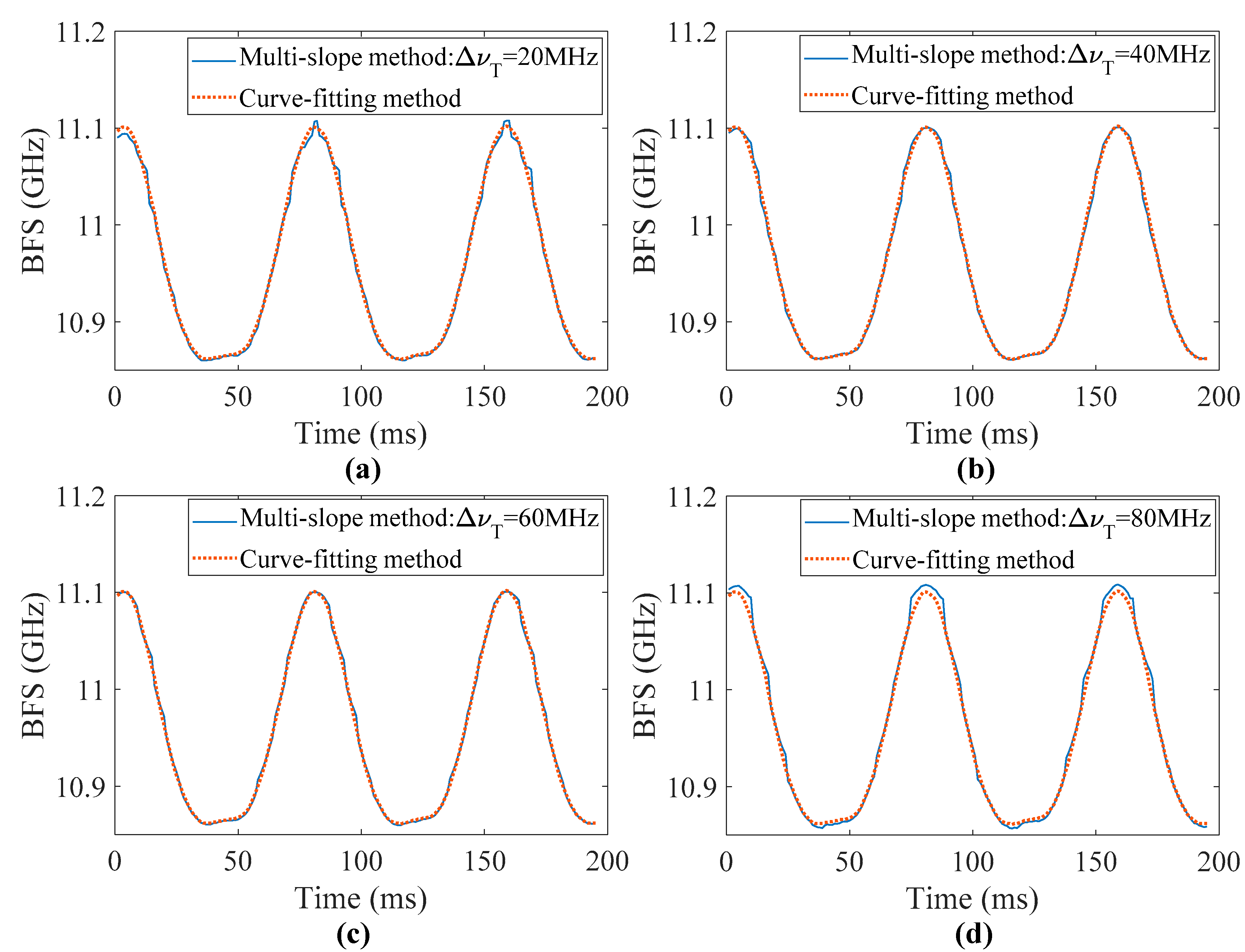
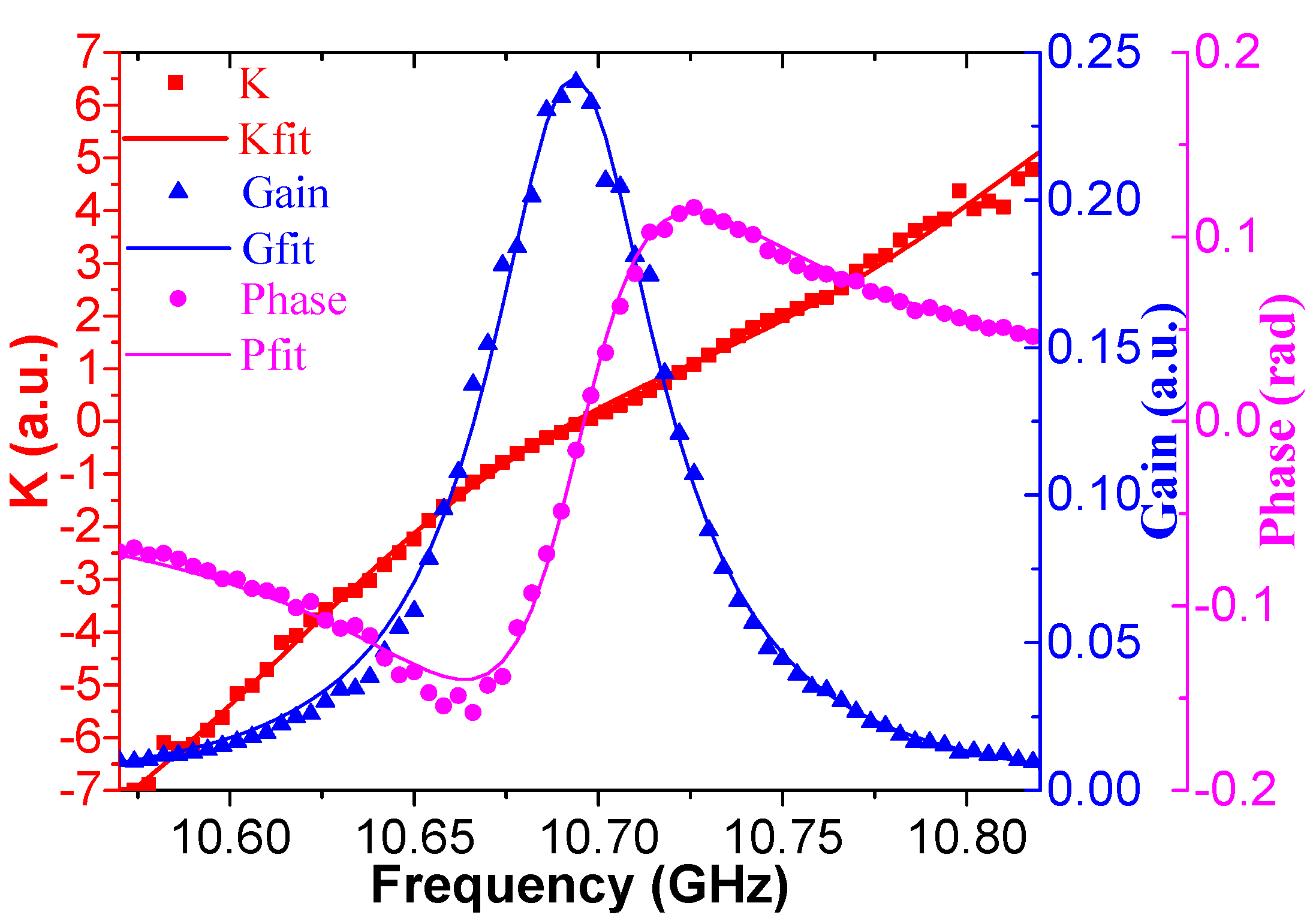
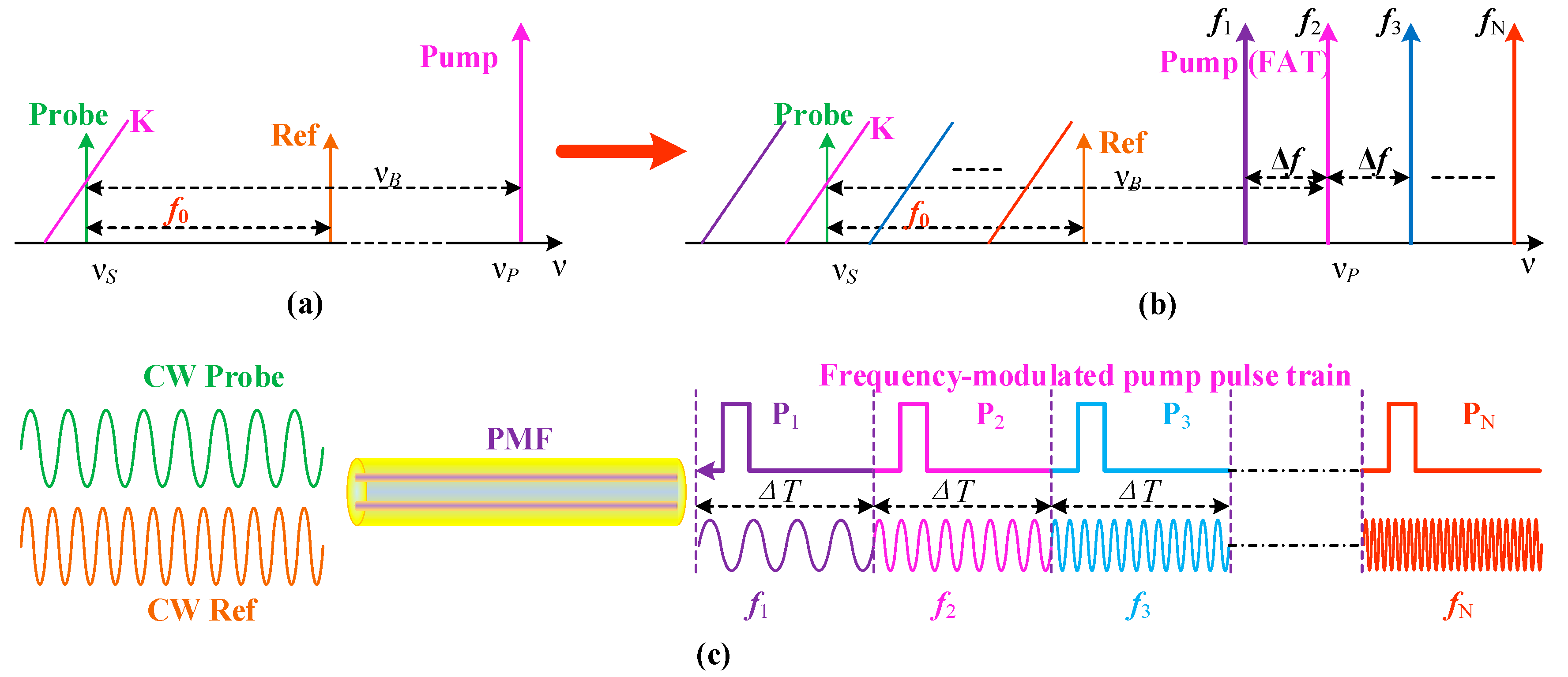
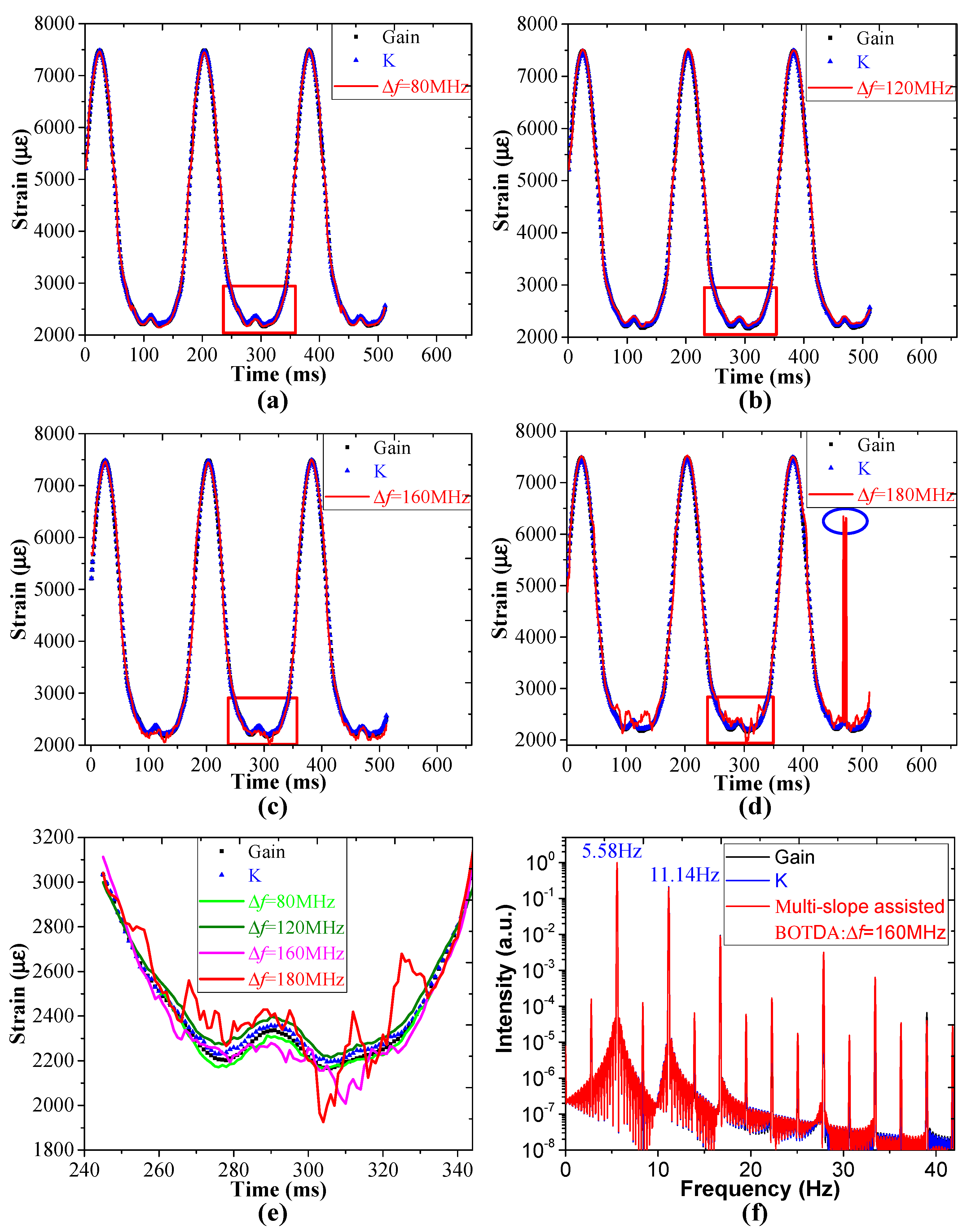



| Time-Domain | Frequency-Domain | Correlation-Domain | |
|---|---|---|---|
| Reflectometer | Brillouin optical time domain reflectometer (BOTDR) [18,19] | Brillouin optical frequency domain reflectometry (BOFDR) [20] | Brillouin optical correlation domain reflectometry (BOCDR) [6,21] |
| Analysis | Brillouin optical time domain analysis (BOTDA) [22,23] | Brillouin optical frequency domain analysis (BOFDA) [24,25] | Brillouin optical correlation domain analysis (BOCDA) [6,26] |
| Averaging Time | Frequency-Switching Time | Effective Frequency-Sweeping Number | |
|---|---|---|---|
| Frequency-sweeping | ~100 | ~ms | ~100 |
| OFC + OFDM | ≥1 | 0 | 1 |
| OFA | ~100 | ~ns | ~100 |
| SA + OFA | ≥1 | ~ns | ≥1 |
| OCC | ≥1 | ~ns | 1 |
© 2018 by the authors. Licensee MDPI, Basel, Switzerland. This article is an open access article distributed under the terms and conditions of the Creative Commons Attribution (CC BY) license (http://creativecommons.org/licenses/by/4.0/).
Share and Cite
Zhang, H.; Zhou, D.; Wang, B.; Pang, C.; Xu, P.; Jiang, T.; Ba, D.; Li, H.; Dong, Y. Recent Progress in Fast Distributed Brillouin Optical Fiber Sensing. Appl. Sci. 2018, 8, 1820. https://doi.org/10.3390/app8101820
Zhang H, Zhou D, Wang B, Pang C, Xu P, Jiang T, Ba D, Li H, Dong Y. Recent Progress in Fast Distributed Brillouin Optical Fiber Sensing. Applied Sciences. 2018; 8(10):1820. https://doi.org/10.3390/app8101820
Chicago/Turabian StyleZhang, Hongying, Dengwang Zhou, Benzhang Wang, Chao Pang, Pengbai Xu, Taofei Jiang, Dexin Ba, Hui Li, and Yongkang Dong. 2018. "Recent Progress in Fast Distributed Brillouin Optical Fiber Sensing" Applied Sciences 8, no. 10: 1820. https://doi.org/10.3390/app8101820
APA StyleZhang, H., Zhou, D., Wang, B., Pang, C., Xu, P., Jiang, T., Ba, D., Li, H., & Dong, Y. (2018). Recent Progress in Fast Distributed Brillouin Optical Fiber Sensing. Applied Sciences, 8(10), 1820. https://doi.org/10.3390/app8101820





